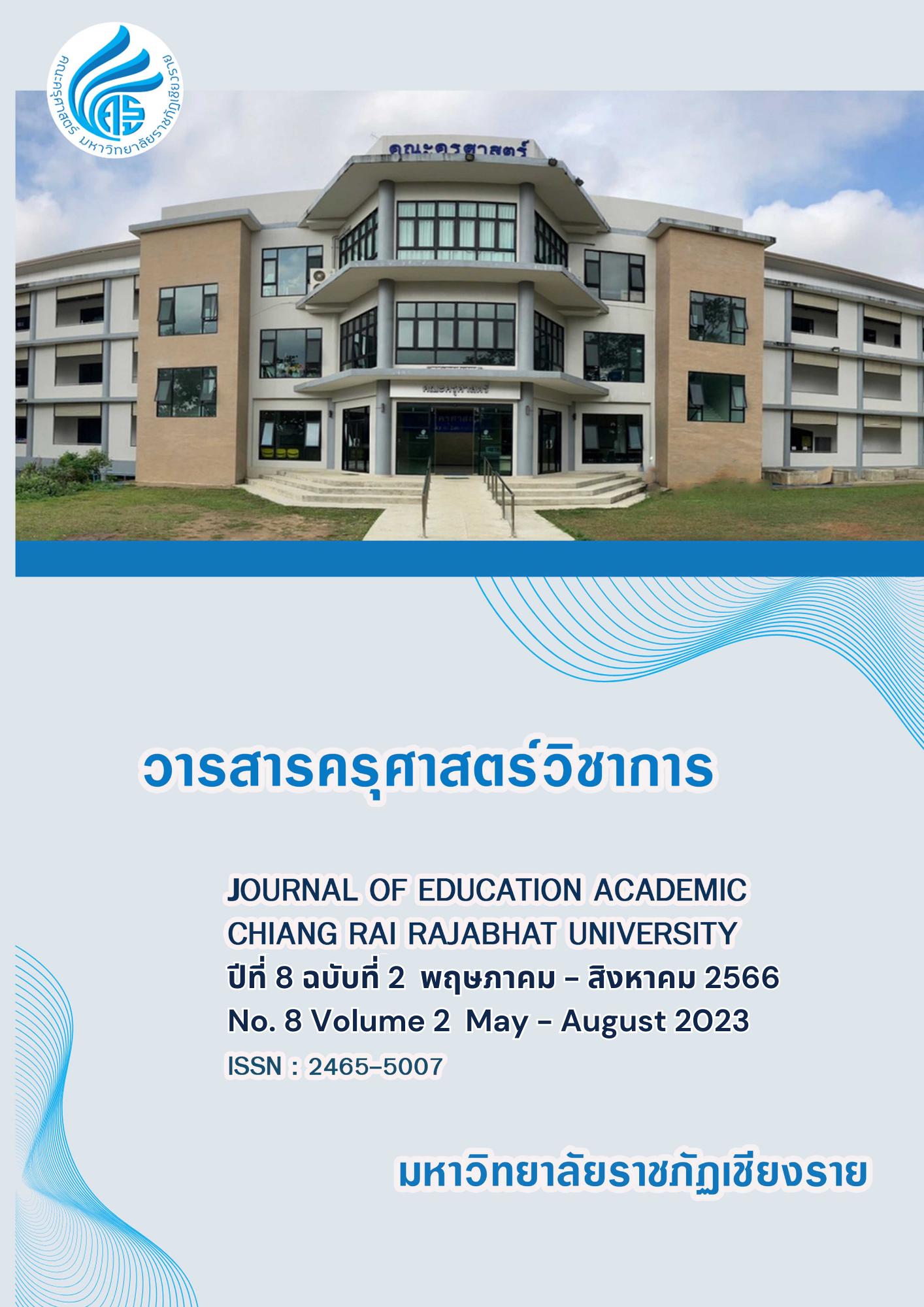Development of Mathematical Word Problem Solving Ability on a System of Linear Equations in Two Variables of the 9th Grade Students Using Cooperative Learning Together Technique Combined with Graphic Organizer
Keywords:
Learning Together, Graphics Organizer, Ability Mathematical, System of Linear Equations in Two VariablesAbstract
This research is Action research. The purpose of this research was to develop 9th grade students' problem-solving abilities. who received learning management using cooperative learning together technique combined with the graphic organizer technique. have a score of at least 70%. The sample group consisted of 30 secondary school year 3/3, Semester 2, Academic Year 2022, obtained from Cluster random sampling. Research tools include: 1) Mathematical learning plan managed by technology collaborative learning. LT (learn together) combined with graphics organizer 2) Problem solving ability test 3) record After the teacher's teaching. The statistics used to analyze data include percentage, average and standard deviation.
The results showed that the students in the sample group had increased scores for the ability to solve problems after the learning management by using the cooperative learning technique combined with the graphic organizer technique. In the first operating cycle, 23 students passed the 70% standard, namely 76.67%. In the second operating cycle, 26 students have passed the 70% standard, accounting for 86.67%, and in the third operating cycle, 28 students have passed the 70% standard, accounting for 93.33%.
References
กระทรวงศึกษาธิการ. (2560). มาตรฐานการเรียนรูและตัวชี้วัดกลุมสาระการเรียนรูคณิตศาสตร์ วิทยาศาสตร์ และสาระภูมิศาสตร์ในกลุมสาระการเรียนรูสังคมศึกษา ศาสนา และวัฒนธรรม (ฉบับปรับปรุง พ.ศ. 2560) ตามหลักสูตรแกนกลางการศึกษาขั้นพื้นฐาน พุทธศักราช 2551 (พิมพ์ครั้งที่ 1). กรุงเทพฯ: โรงพิมพ์ชุมนุมสหกรณ์การเกษตรแห่งประเทศไทย จำกัด.
ทิศนา แขมมณี. (2564). ศาสตร์การสอน องค์ความรู้เพื่อการจัดกระบวนการเรียนรู้ที่มีประสิทธิภาพ. กรุงเทพ: สำนักพิมพ์จุฬาลงกรณ์มหวิทยาลัย.
บุญชม ศรีสะอาด. (2545). การวิจัยเบื้องต้น (พิมพ์ครั้งที่ 7). กรุงเทพฯ: สุวีริยาสาส์น.
. (2553). การวิจัยเบื้องต้น (พิมพ์ครั้งที่ 8). กรุงเทพฯ: สุวีริยสาส์น.
เบญจรัตน์ เปรมปรีสุข. (2564). การจัดการเรียนรู้โดยใช้เทคนิคการเรียนรู้แบบร่วมมือ LT เพื่อพัฒนาผลสัมฤทธิ์ทางการเรียน เรื่อง กราฟและความสัมพันธ์เชิงเส้น ของนักเรียนชั้นมัธยมศึกษาปีที่ 1. The New Viridian Journal of Arts, Humanities and Social Sciences, 5(1), 24-36.
ประสาท เนืองเฉลิม. (2563). วิจัยการเรียนการสอน (พิมพ์ครั้งที่ 4). กรุงเทฯ: สำนักพิมพ์จุฬาลงกรณ์มหาวิทยาลัย.
พรทิพย์ อุดร. (2550). การเปรียบเทียบผลสัมฤทธิ์ทางการเรียนวิชาวิทยาศาสตร์และความสามารถในการคิดอย่างมีวิจารณญาณของนักเรียนชั้นมัธยมศึกษาปีที่ 3 ที่เรียนด้วยวิธีการเรียนรู้แบบบูรณาการกับการจัดการเรียนรู้แบบร่วมมือรูปแบบ STAD. (วิทยานิพนธ์ครุศาสตรมหาบัณฑิต). พระนครศรีอยุธยา: มหาวิทยาลัยราชภัฏ
พระนครศรีอยุทธยา.
สัมพันธ์ พันธ์พิมพ์. (2565). ข้อมูลนักเรียนโรงเรียนท่าคันโทวิทยาคาร. สืบค้นเมื่อ 11 พฤศจิกายน 2566. เข้าถึงได้จาก https://data.bopp-obec.info/web/index_view_ stu.php? School_ID= 1046030625&Edu_year=2565&p=y
สุวร กาญจนยูร. (2533). เทคนิคการสอนคณิตศาสตร์ระดับประถมศึกษา เล่ม 3. กรุงเทพฯ: ไทยวัฒนาพานิช.
สมเกียรติ อินทสิงห์. (2559). การพัฒนาความสามารถในการแก้ปัญหาและผลสัมฤทธิ์ทางการเรียนวิชาคณิตศาสตร์โดยใช้ กลวิธี STAR ร่วมกับกราฟิกออแกไนซ์เซอร์ สำหรับนักเรียนชั้นมัธยมศึกษาปีที่ 4. Veridian E-Journal,Silpakorn University ฉบับภาษาไทย สาขามนุษยศาสตร์สังคมศาสตร์ และศิลปะ, 9(1), 356-368.
อภิเดช ธิตะปัน, และ วัชรินทร์ ศรีรักษา. (2563). การพัฒนาการจัดกิจกรรมการเรียนรู้เรื่องศิลปะจากต้นกล้วย ด้วยการจัดการเรียนรู้แบบร่วมมือ เทคนิคLT ร่วมกับการสอนแบบสาธิต ของนักเรียนชั้นประถมศึกษาปีที่ 2. รายงานสืบเนื่องการประชุมวิชาการเสนอผลงานวิจัยระดับบัณฑิตศึกษาแห่งชาติ ครั้งที่ 21, 762-773.
Hergenhahn, B.R. and Olson, M. (1993). An introduction to theories of leaning 4th ed. United States: Prentice-Hall.
Kemmis, S & Mc Taggart, R. (1998). The Action Research Planer. 3rd ed. Victoria: Deakib University.45.
Downloads
Published
Issue
Section
License
Copyright (c) 2023 Journal of Education Academic Chiang Rai Rajabhat University

This work is licensed under a Creative Commons Attribution-NonCommercial-NoDerivatives 4.0 International License.






